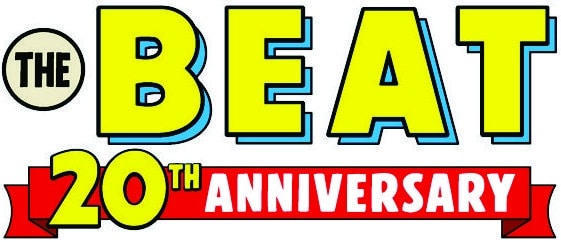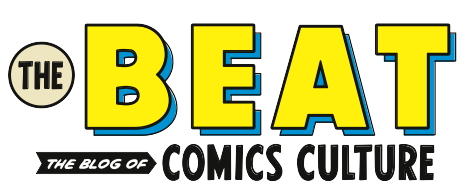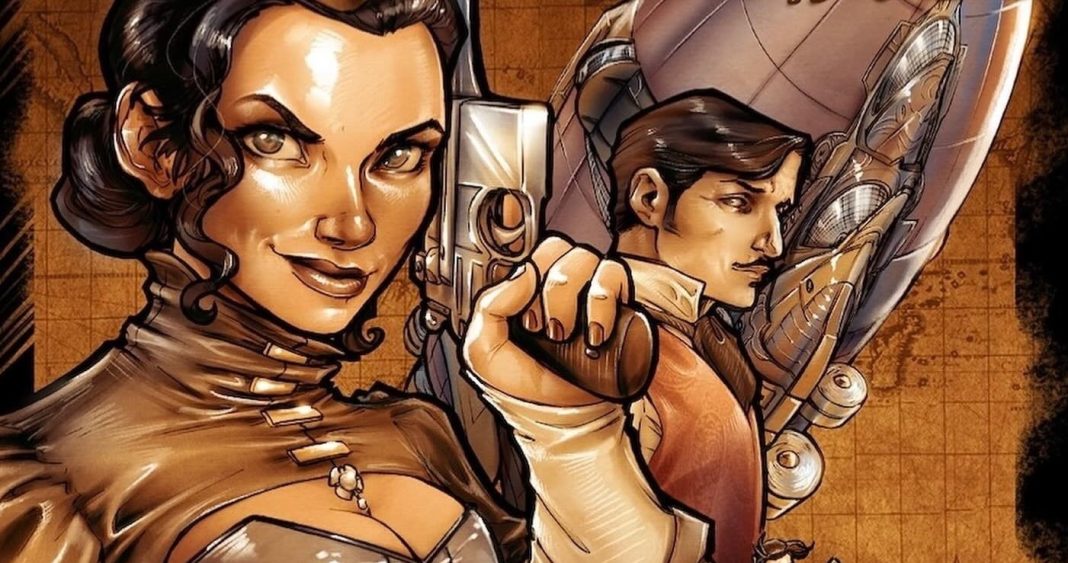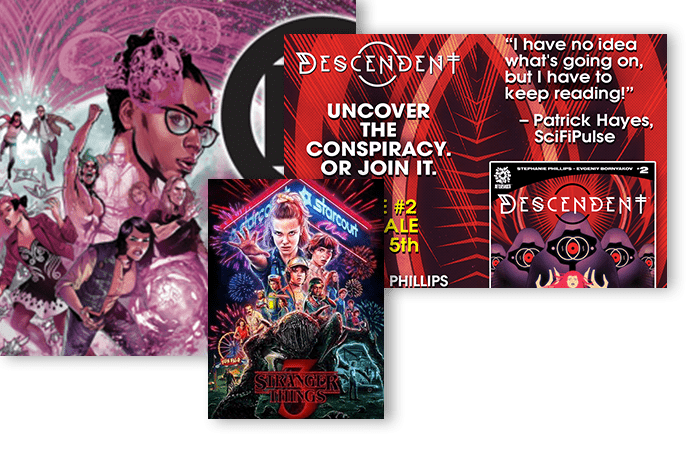The Beat had the pleasure of chatting with the duo about their experience working in comics for the first time and the potential future for Topsy McGee.
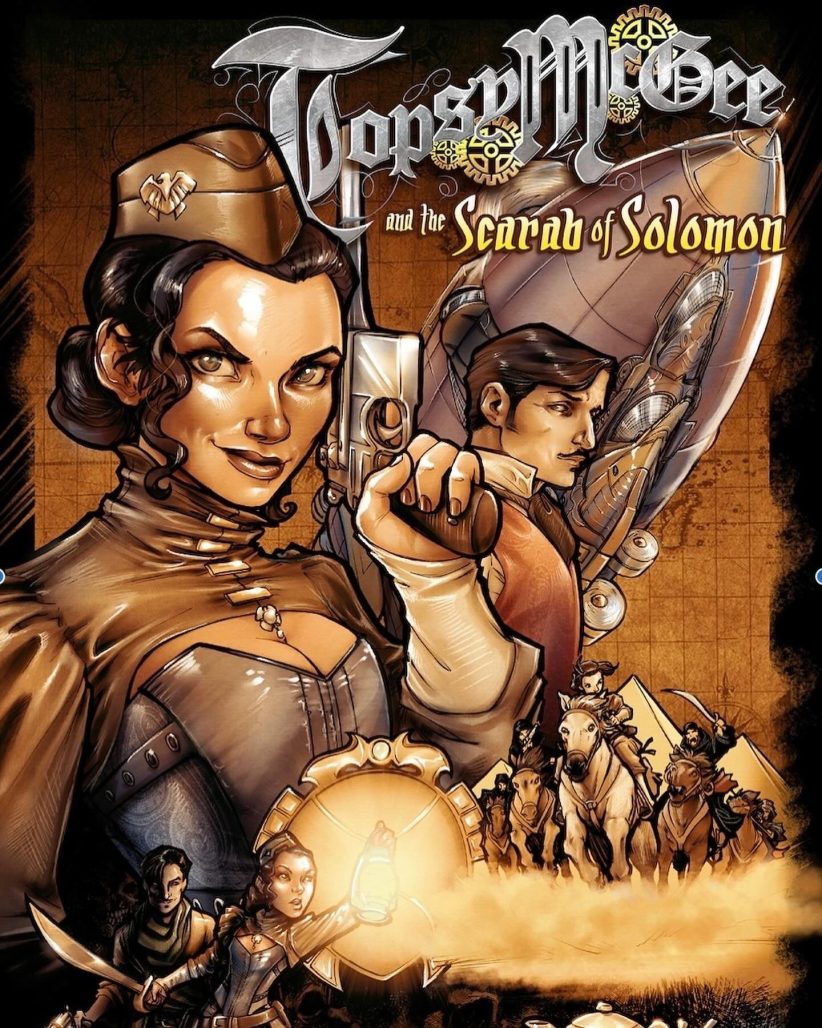
Taimur Dar: For me, the story the conception of a project is just as interesting as the story itself. So, the obvious first question is how the characters of Topsy McGee and Sean McGee came about?
Lowenthal: It’s a twisty path and I’m glad you’re interested because it started a long time ago.
Platt: Ever since we got married, when we have a little bit of time, we just tell each other stories like if we’re waiting on a bus or stuck doing something for a while. We created this Topsy McGee strong heroine who likes her tea but can also manage a rapier. We just played with her as a character verbally adding stories back and forth.
Lowenthal: Once when I was at a convention, I saw an artist that I really liked. I commissioned for Tara’s birthday, without her knowing, a piece of artwork of her as that character.
Platt: It was amazing. Seeing her in print sort of made her real. Seeing this beautiful commissioned artwork present that he gave me was the tipping point to us actually thinking maybe we could do something with it other more than us entertaining each other.
Lowenthal: At a renaissance fair there was somebody who did amazing custom work. We got in touch with them and sent them the artwork and her measurements. They created this amazing costume which was great for costume parties. But…
Platt: Now we had this costume and with our expertise for film, we decided to make a short film because why not? It’s what we’re used to doing. It allowed us to play Topsy and her husband on camera. We got to do really fun stunts. We worked with a really great stunt team. It came to life in its own way in its own fun pocket.
Lowenthal: We had to get really creative because that world is not cheap.
Platt: We had to build an entire airship.
Lowenthal: We built an airship set in our old production studio. It was not the smart way to do it.
Platt: We loved it so much and were so proud of it that our friend of ours who is a writer…
Lowenthal: Chris Pearson, who created a show a while ago called Dan vs., he loved the world and the ideas we were playing with. He said, “Could I write a pilot for that for TV?” We said, “We would love to see that.”
Platt: You mean you like our characters too? Yes, please!
Lowenthal: So we wrote this pilot and with the production team we had made the short film, we started shopping it around. But it was a very bad time for steam punk in television. So it didn’t really go anywhere. But the characters and the stories in that world…
Platt: [They] had their claws in us!
Lowenthal: We thought, how else can we continue to tell this story and have a little more control over? When you’re pitching something you have to wait for somebody to greenlight your project. We don’t like to wait around for that.
Platt: You said we should do a comic book. We could have written a novel. But I think the reason you brought up comics is because we wanted to keep it very visually aesthetic and stimulating. That’s how the idea of a comic was born and how we could retain power and control over what’s going on and financially be able to manage and navigate it. We weren’t able to create the on-camera version for the budget we had unless someone greenlit it. Then it was a whole learning curve of how do we make comics.
Lowenthal: We knew how to make movies and books but we did not know how to make comics. Enter Comfort Love, as they are known in the comic book world Comfort Love and Adam Withers who we had also met a convention.
Platt: All of our contacts are at conventions. [Laughs].
Lowenthal: We reached out to them and said, “You guys make brilliant comic books. We’ve never done this before. Would you help us shepherd us through this?” They were so instrumental in making this comic book come to life. Every time we didn’t know the next step was, they did.
Platt: Even though we made plenty of mistakes. Like trying to fix things while they were still lettering.
Lowenthal: We learned that this process also takes a really long time. We have a little more control over it. But when you’re paying everybody yourself and don’t have a big comic book studio breathing down your neck for the next issue and the structure to make it all happen, it can take a while.
Platt: Even though we had scripted out the first three issues of comics, it was taking so long that Yuri quickly realized it wasn’t fair to try to release a comic and then not have a deadline when the next issue was coming out.
Lowenthal: We knew enough to know when you wait a long time between anything you’re making, people can lose interest. Rather than put out an issue then another issue, we decided to finish all of them and the format of a trade paperback or graphic novel would be more suited to tell this particular story.
Platt: Although now we’re considering what if it was an animated series since we have so many contacts there.
Lowenthal: It’s silly we didn’t think of that first. It was staring us right in the face!
[Laughter]
Dar: It’s funny you discuss your prior experience in TV and film versus comics. As you are well aware, I’m a huge fan of Dwayne McDuffie. Although he excelled at both, I remember him saying on a panel he preferred screenwriting or at least found it easier than comics. I’m curious if you found the experience writing this Topsy McGee story for the comics medium easier or harder than you expected?
Platt: It’s tricky. I think because when you write, whether it’s animation or live-action, you have a little more flexibility with your descriptions and dialogue. Yes, you want to edit and be succinct and tell your story in the best possible way. But you have freedom of space. With a comic, everything is so precious because you have to explain to an artist what they need to translate from your description to make the image on the page look right. But you also only have these tiny little bubbles to fit yours words in that have to be the dialogue to get the entire story expressed. I think that’s definitely a skill set. It’s a different type of writing than you would do for an animated show.
Lowenthal: When I was writing the script for this book, I would have to go back and forth with Comfort and Adama and ask, “Is this an okay format to send to artists?” You have to be more specific in what images you want. Normally I don’t have to think about the images and someone else thinks about that. Because comics is what it is, I had to think more specifically about what we wanted to show and [how] the eyes come down the page. We really worked with the artists and Comfort and Adam to craft better scripts that artists could work with. It was definitely a learning curve. I understand why Dwayne would say that.

Platt: Because the way we went about it wasn’t knowing the trade paperback would be the way it ended up, we were at first focused on getting that first issue out. The artist we found Denis [Medri] whose style really spoke to Yuri.
Lowenthal: Again, Comfort and Adam helped us go through artists that we found and their portfolios. Luckily we found Denis and was an amazing way to start the book.
Platt: But he was also blowing up right when we were asking him to do our book. He got really busy and [it] looked like the timeline of us finishing was going to be very nebulous. At that point that’s when we decided each issue would be a different artist. It allowed us to keep moving forward. From there we worked with Comfort and Adam and looked at portfolios.
Lowenthal: Also to cultivate new upcoming artists.
Platt: It was also about something that appealed to both of us. I’m not saying the art in here is grotesque, but Yuri has a style that he likes that is a little dark and little more grotesque. I just don’t want it to be scary. We had to find something that felt evocative and active and adventurous while still having a darkness to it while also having fun. We would find artists that worked for both of us and then we would reach out and connect.
Dar: Having interviewed many entertainers over the years, I never assume they’re comic book readers. So it always feels like making a special connection whenever I interview a fellow comic reader. A perfect example is actor David Dastmalchian who wears his fandom on his sleeves and has been making his mark in the comics industry for the last few years. I know Yuri’s love of comics goes back to reading Frank Miller’s Dark Knight Returns, so I’d love to hear about both of your past and current comics fandoms?
Lowenthal: It’s a funny history!
Platt: I did have a pull list when I was a kid. But my pull list wasn’t any superheroes. I had Scrooge McDuck, Archie and Betty and Veronica stuff. It was a little lighter. I didn’t have a TV growing up but it’s almost in a way that the comics were my Saturday morning cartoons. Nothing too scary or dangerous. With Richie Rich you know exactly where he’s going. That was more my level.
Lowenthal: I’m definitely more a superhero guy. Recently I have not been reading too many comics as I used to. I find it overwhelming. Usually I end up reading stuff that people have recommended to me or new Mat Fraction or Matt Wagner. For some reason I only read Matts! I gravitate towards [comics] either someone has recommended it or a characters I’m familiar with like Moon Knight. I don’t read like I used to. I don’t have a pull box anymore.
Platt: But they know you at the comic shops.
Lowenthal: That’s true. But that’s because of Spider-Man.
Platt: No! They know you!
Dar: You mentioned an animated series, but where next do you want to take the the world of Topsy McGee?
Platt: I feel like there’s still stories to tell with them. And I do feel in the world we’re living in, there’s a lot you can learn from history, even a steampunk alternative history. You can take what’s going on with that and make commentary with what’s going on in the world. I think there’s a necessity for characters like them.
Lowenthal: What we’re saying is three’s more to explore in whatever form it happens next.
Topsy McGee and the Scarab of Solomon TPB will be available on October 9th, 2024.
Globetrotting Action at the Dawn of the 20th Century!
Topsy McGee and her husband Captain Sean McGee are England’s premier adventurers. They’ve traveled the world, surviving all manner of scoundrels, brutes, and villians both mundane and mysterious, with flair, and pluck. But never before has danger struck this close to home.
When Topsy receives a telegram from her father, an airship ride to Cairo is only the beginning. Topsy and Sean take on goons, assassins, and cultists with the help of allies like Harry Houdini and Captain Nemo. Will they be able to learn the truth of the Scarab of Solomon before it is used against them?
It’s a race against time in a steampunk world that could have been, with the fate of their family — and the world — in the balance.
Story by Yuri Lowenthal and Tara Platt, Written by Yuri Lowenthal, Art by Denis Medri (Issue 1), Art by Will Jones (Issue 2), Art by Hanna Al-Shaer & Hailey Mramor (Issue 3), Color by Will Jones (Issue 1, 2), Color by Theodora Marron and Comfort & Adam (Issue 3), Color Separations by Malena Salinas and Dylan Klingler, Lettering by Deron Bennet (Issue 1), Lettering by Comfort & Adam (Issue 2, 3), Covers by Comfort & Adam, Production & Editorial by Comfort & Adam
